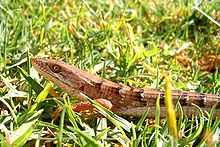Southern alligator lizard
| Alligator lizard | |
|---|---|
 | |
| Conservation status | |
| Scientific classification | |
| Kingdom: | Animalia |
| Phylum: | Chordata |
| Class: | Reptilia |
| Order: | Squamata |
| Family: | Anguidae |
| Genus: | Elgaria |
| Species: | E. multicarinata |
| Binomial name | |
| Elgaria multicarinata Blainville, 1835 | |
.png) | |
The Southern alligator lizard (Elgaria multicarinata) is a lizard native to the Pacific coast of North America.[1] It is common throughout Southern California and can be found in grasslands, chaparral, and forests as well as urban areas.[1] In dry climates, it is likely to be found in moist areas or near streams.[1] Three subspecies can be distinguished: the California alligator lizard (E. m. multicarinata), the San Diego alligator lizard (E. m. webbii), and the Oregon alligator lizard (E. m. scincicauda).[2]
The southern alligator lizard has a long, somewhat prehensile tail, up to twice the length of its body.[1] Like many lizards, however, it can drop its tail if attacked, possibly giving it a chance to flee;[1] the tail will regenerate, but will never be as long or richly colored as the original. Individuals with intact tails can reach up to about 11in total length.
The lizards can frequently be found near human habitation and are notable for their fearless self-defense; they will often bite and defecate if handled.[1] In the wild they eat small arthropods, slugs, lizards, small mammals and occasionally young birds and eggs.[2]
Gallery
-
Elgaria multicarinata subsp. webbii (Baird, 1859); Yosemite National Park
-

Southern alligator lizard, West Los Angeles
-

Southern alligator lizard, Central Valley
See also
References
- ↑ 1.0 1.1 1.2 1.3 1.4 1.5 "Southern alligator lizard". San Diego Zoo Factsheets. San Diego Zoo. October 2008. Retrieved June 24, 2013.
- ↑ 2.0 2.1 Stebbins, Robert (2003):331. A Field Guide to Western Reptiles and Amphibians, Houghton Mifflin. ISBN 0-395-98272-3
- "Elgaria multicarinata". Integrated Taxonomic Information System. Retrieved 6 February 2006.
External links
| Wikimedia Commons has media related to Elgaria multicarinata. |

